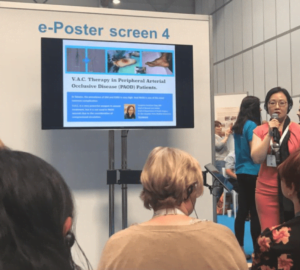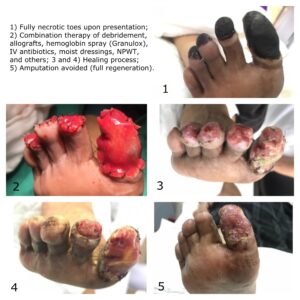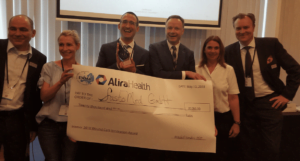EWMA 2018 (9-11 May) has just come to a close in beautiful Krakow, Poland. This annual global wound care conference is wonderful, bridging scientific, clinical, and industry stakeholders from around the world (most other annual wound conferences tend to draw from relatively regional audiences). Here are four key takeaways:
1. Less influence from reimbursement dictates
With a global audience, the relative importance of product reimbursement diminishes (but doesn’t disappear), and there is a higher emphasis on product innovation, practicality, and cost-benefit trade offs. Clinicians visiting the exhibition booths were interested in many less-conventional treatment options than we typically see with those focused on North American and Western European settings.
For example, I observed an in depth discussion between a group of Indian clinicians and a vendor at the booth of a new technology that is struggling with reimbursement in the developed markets. Since all of their patients pay cash for advanced wound care–whether a cleanser, advanced dressing, NPWT, allograft, or this particular new therapy–the value proposition to these clinicians was on a relatively level playing field with other treatment options, and they therefore demonstrated considerable interest.
Even Poland (where the conference was hosted this year) is an emerging market, with many similar cost considerations. Accordingly, there was an abundance of Polish wound care providers and distributors attending, and I spent a lot of time learning from their discussions and which clinical, operational, and financial challenges and solutions had their attention. I often find that observing interactions between clinicians and vendors yields more valuable insights than discussing with each party separately.
2. What’s on industry’s mind…
For those of us who know senior management and investors in the industry, it’s always enlightening to pay attention to which sessions and booths they show up to (and their level of interest / engagement). When one looks around the room and sees key decision makers from several major companies attending the same session, it reveals an implied interest in particular clinical solutions, therapies, or companies. This was apparent in Krakow this year. Wound care executives were also eager to learn how to better commercialize existing products internationally, especially in the emerging markets–with a renewed openness to new business models.
3. Creative approaches to existing and new technologies
- Dr. Huei-chun (Josephine) Tang, Chief of both Plastic Surgery and Wound Care at An-Nan Hospital in Tainan, Taiwan presented a very compelling e-poster series of patients with PAOD (peripheral arterial occlusive disease) who received KCI’s VAC NPWT at the regular -125 mmHg pressure setting after revascularization. In my experience, some wound care providers I worked with are concerned about using NPWT in PAOD patients–and that’s quite understandable, as ensuring adequate oxygenation is a top clinical goal and many worry that the various NPWT components or mechanics might interfere with local perfusion or create minor skin injuries that can deteriorate into complex wounds. But as Dr. Tang demonstrated in her series, together with revascularization, debridement, and especially an emphasis on good multidisciplinary communication among the care team, certain patients with arterial ulcer diagnoses may still benefit from NPWT at the normal pressure setting. None of the patients in the series had a major amputation after receiving the therapy.

Dr. Huei-chun (Josephine) Tang of Taiwan presents a case series using KCI (Acelity)’s NPWT for holistically and successfully treating arterial ulcers. - Dr. Colin Krueger, Head of Surgery and Robotic Surgery and at Immanuel Klinik in Berlin, Germany discussed a novel use for hypochlorous acid (Granudacyn). While it’s most frequently used as a wound cleanser solution, he has also been applying it during cases of necrotizing pancreatitis. Since the solution turns into water and salt, he creatively uses it as a lavage during laparoscopic surgery, and in doing so has seen the mortality rate for his patients drop from around 30% to 0%. He walked the audience through a recent, complex case, including the diagnostic, medical, and surgical approach taken to achieve the positive outcome. The audience was impressed by the innovative yet sensible use of the product beyond just open wounds.
- Likewise, Dr. Borripatara Wongpratchum (“Dr. B”), plastic surgeon at World Medical Center in Bangkok, Thailand impressed the audience by demonstrating how aggressively yet holistically treating necrotic toes in a very complex patient, he was able to regenerate virtually all of the tissue! The audience was in awe, because even “top” wound care clinicians would accept as fact that the necrotic regions of the toes must be totally amputated (hopefully addressing the underlying causes in parallel), with the actual wound care only beginning post-amputation. Yet with debridement, moist dressings and NPWT, application of hemoglobin spray (Granulox), IV antibiotics, offloading, PRPs, and an acellular dermal matrix, Dr. B and his team were able to “resurrect” the dead toes, eliminating the need for amputation. I didn’t believe it until I saw it–so for those who missed the session, I’ll let the photos speak for themselves:

4. The Innovation Symposium
At Alira Health’s Advanced Wound Care Innovation Symposium, one of my favorites among all global wound care conferences, all four companies participating presented innovative solutions to key wound care challenges–from practical usage to gene editing and other novel microbiological approaches. After the presentations, a round of questioning by the judges, and deliberations, the €20,000 first place prize was awarded to SastoMed, who presented their Granulox hemoglobin spray (used on over 65,000 patients in over 40 countries, but not yet registered in the US).

If you missed Alira Health’s EWMA session, you can get the flavor of the first-place winner from my interview with SastoMed Founder and CEO Michael Sander at SAWC Fall 2017 below:
We’re already looking forward to EWMA 2019 (5-7 June, 2019…not next month!), which will be held in Gothenburg, Sweden.




Superb blog, if that’s direction woundcare industry is heading in future then it is a great news for everyone.